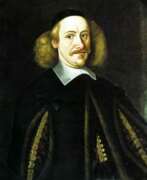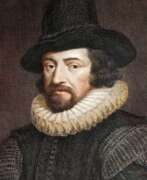Jurists 17th century


Jan (Joan) Willemsz. Blaeu was a Dutch cartographer, publisher and judge.
Jan was born into the family of the cartographer and publisher Willem Janszoon Blaeu (1571-1638). He studied in Leiden, where he earned a doctorate in law, and in Padua. He then began to assist his father, who was engaged in the manufacture of globes and maps. After his father's death, Jan, together with his brother Cornelius, continued his work, and succeeded him as cartographer for the Dutch East India Company.
In 1651 Blaeu was elected to the Amsterdam city council and later appointed as a judge. At the same time, he was engaged in his publishing business: he continued to publish volumes of Atlas novus, which contained maps of English counties and, for the first time, an atlas of Scotland, as well as one volume of maps of the Far East.
Blaeu did not have time to complete his most ambitious project, but it made him famous as the author of the famous 11-volume Dutch atlas. Based on his previous maps, Blaeu created the Great Atlas (Atlas Maior) - it contained nearly 600 maps and a total of 3,000 pages of Latin text - and was published in 1662. Blaeu's maps were groundbreaking for their time because they were created in accordance with the heliocentric theories of Nicolaus Copernicus.
In 1672, a great fire in Amsterdam destroyed Blaeu's workshop, and the cartographer died a year later, apparently never recovering from this stroke of fate.


John Hathorne was a merchant and justice of the peace of the colony in Massachusetts, United States.
Hathorne's father, Major William Hathorne, was among the first settlers of the Massachusetts Bay Colony in the 1630s, holding a number of military and political positions over several decades.
John Hathorne himself is known for having participated as a justice of the peace in 1692 in the famous Salem Witch Trials during the witchcraft hysteria. Extant documents prove that Hathorne was the chief prosecutor, convinced of the guilt of the accused. The trial ended with the execution of 20 people, and John Hathorne never repented, although the High Court later acquitted most of the accused. He was appointed a member of the Superior Court in 1702 and sat on it for ten years.
John was the great-great-grandfather of the writer Nathaniel Hawthorne (1804-1864), author of many works, including The Scarlet Letter and The House of the Seven Gables. They are set in Salem and contain allusions to the witch trials in the history of the house. John Hathorne's personality has served as a prototype for the bigoted and demonic characters of many works by other authors. And Nathaniel Hawthorne himself changed the spelling of his surname to distance himself from his ancestor.


Gottfried Wilhelm Leibniz was a German philosopher and a prominent polymath in many fields of science.
Leibniz was a universal genius; he showed his talents in logic, mathematics, mechanics, physics, law, history, diplomacy, and linguistics, and in each of the disciplines he has serious scientific achievements. As a philosopher, he was a leading exponent of 17th-century rationalism and idealism.
Leibniz was a tireless worker and the greatest scholar of his time. In the fate of Leibniz, among other things, there is one interesting page: in 1697, he accidentally met the Russian Tsar Peter I during his trip to Europe. Their further meetings led to the realization of several grandiose projects in Russia, one of which was the establishment of the Academy of Sciences in St. Petersburg.
Gottfried Wilhelm Leibniz was also the founder and first president of the Berlin Academy of Sciences and a member of the Royal Society of London.


Giuseppe Rosaccio was an Italian physician, astronomer, cosmographer and cartographer.
Rosaccio graduated from the University of Padua, studied philosophy, medicine and law, and worked as a physician and judge. He became famous for a series of works that popularized a number of scientific disciplines. Some of his books deal with astrological medicine, specific diseases and their remedies, and the distillation of medicines from plants.
Giuseppe Rosaccio wrote about forty works on various topics of interest to him, but the main one was geography. He wrote an essay on the Muslim religion and treatises on geography, cosmography, astronomy, and astrology, which became very popular and were repeatedly reprinted.
Rosaccio created many atlases and small-format geographical works. Among his works is Ptolemy's Geography, which contains many indexes and is written in Italian (1599). He also authored a large map of the world (1597), and a large map of Italy and Tuscany (1609). His book Journey from Venice to Constantinople includes maps of the route with brief texts, that is, it is essentially an illustrated version of a pilgrimage to the Holy Land.


Otto Guericke, from 1666 von Guericke (pronunciation and original spelling: Gericke) was a German politician, jurist, physicist and inventor. He is best known for his experiments on air pressure with the Magdeburg hemispheres. He is considered the founder of vacuum technology.

















